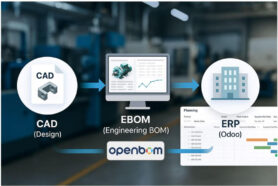
If you put a frog into boiling water, it will jump out immediately. The frog’s survival instincts are geared towards detecting sudden changes. This story is warning us to pay attention to threats that are slowly increasing. Something like expenses, mistakes, productivity decrease, and similar. Once upon a time, you decided that dumping BOM into Excel from your 3D CAD system is a simple and good idea that helped you to create a list of components to build your product lifecycle management and data management strategy. Since then, you created a large number of Excels, you have many duplicated records about parts in your Excels, you cannot find what is the last Excel file and what to send to your purchasing department and you don’t know how a BOM from your last released product looks like.
In fact, you’ve been boiled like a frog in your slowly increasing numbers of problems created by the decision to manage engineering data, bill of materials, and product lifecycle using Excel. But despite the water warming up, the organization still feels comfortable. And the biggest comfort comes from the fact that you don’t need to make any changes. Even the crappiest system replacement is a change and engineers in your organization won’t be very much happy to change it. Check my earlier article explaining how engineers don’t like to get out of their comfort zone.
How to jump out of Excel bad habits?
Pandemic years and digital transformation and supply chain shortages have triggered changes and a sense of urgency for many organizations. However, you still need to have that “aha moment” for many manufacturing organizations to think about how to stop managing their business processes using the Excel-ware universe. After speaking to many organizations, we discovered that many of them are using the same “boil the frog” strategy but in the opposite direction. Here is how it can work…
You can take an engineering or manufacturing team and instead of switching them one day from their old and comfy Excls to a fully-fledged PLM platform, we make them jump immediately and reject the change. At the same time, if you bring PLM and other digital services to an organization, changing existing data management practices and business processes gradually, your engineers are getting ready for PLM and adopting the change.
Agile PLM services adoption is the way for many manufacturing companies today to think about their digital transformation strategy. You can ask – PLM vendors always offered the agile gradual adoption approach avoiding PLM big bang change event. It is true, but here is the thing – new modern PLM SaaS Digital Web services make a difference in the way new platforms can be adopted and used.
OpenBOM Digital Web Services
How can new product lifecycle management digital web services help to set up a new approach in digital transformation and adopt digital technologies gradually replacing old and inefficient engineering BOM management using Excel and setting up a new strategy for manufacturing companies? OpenBOM’s 3 distinct characteristics and features are actually making it happen.
Free registration and free trial
Although you can find a number of SaaS product lifecycle management software available around, OpenBOM provides you an easy and simple way to register and start using the system instantly. It is the way engineers can develop trust and proof the point of how OpenBOM can help.
Seamless CAD Integrations
The excel-ware journey starts with an easy process to export data from CAD and flexible data management. OpenBOM gives you seamless CAD integrations with a one-click BOM function capable of getting data from CAD without any extra effort. But OpenBOM takes it to the next level allowing sync and merge of changes into data modified by other people in the organization.
Excel-like user experience and flexible data model
People don’t want something truly new, they want the familiar done differently. This is how OpenBOM uses a very similar spreadsheet-like user experience while providing structured data and file management combined with revision and change management process support.
Conclusion
Similar to boiling frogs in warm water, engineering teams and manufacturing organizations keep using Excels and diving into poorly organized data, inefficient processes, complex supply chains, and the absence of digital data to drive their business processes. Existing legacy PLM systems are way too much for many of these organizations and many PLM vendors are offering the same legacy PLM products hosted in the cloud as “new SaaS” product lifecycle management tools. New business systems and new technologies developed by OpenBOM can knock out the “boiling frog” process and help organizations get out of their comfort zone. You can start using OpenBOM instantly and gradually transform data management methods and business processes.
REGISTER FOR FREE to learn how OpenBOM can help you today.
Best, Oleg
Join our newsletter to receive a weekly portion of news, articles, and tips about OpenBOM and our community.










